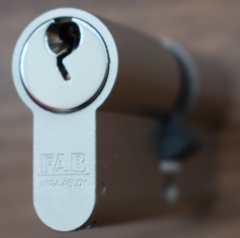FAB 1000: Difference between revisions
(Added the patent.) |
mNo edit summary |
||
| Line 15: | Line 15: | ||
}} | }} | ||
''' | The '''1000''' is a [[pin-tumbler]] lock made by [[FAB]]. It is one of two locks in [[FAB]]'s current portfolio belonging to a resistance class 4 (according to CSN P EN1627:2000), which is the highest resistance class FAB offers. | ||
__TOC__ | __TOC__ | ||
<br clear="all"> | <br clear="all"> | ||
== | == Principles of operation == | ||
:''See also: [[Pin-tumbler#Principles_of_Operation|Pin-Tumbler (Principles of Operation)]]'' | |||
The lock contains five pin stacks, with two chambers containing standard drivers, two chambers contain [[RBC]] pins and there is a single spool. This configuration hints that the manufacturer perceives dynamic methods as a higher threat than picking (although RBC pins can frustrate picking as well). | The lock contains five pin stacks, with two chambers containing standard drivers, two chambers contain [[RBC]] pins and there is a single spool. This configuration hints that the manufacturer perceives dynamic methods as a higher threat than picking (although RBC pins can frustrate picking as well). | ||
| Line 29: | Line 31: | ||
The key is protected with both patent application and utility model; the blanks are restricted and key can be cut or copied only when locksmith is presented with a security card. | The key is protected with both patent application and utility model; the blanks are restricted and key can be cut or copied only when locksmith is presented with a security card. | ||
== | == Disassembly instructions == | ||
To disassemble a double euro cylinder, use of a pinning shoe is the preferred method. | To disassemble a double euro cylinder, use of a pinning shoe is the preferred method. | ||
Latest revision as of 23:29, 24 March 2022
FAB 1000
| FAB 1000 | |
 | |
| Name | FAB 1000 |
|---|---|
| Manufacturer | Fab |
| Lock Type | Cylinder |
| Lock Design | Pin-tumbler |
| Patent | CZ304946B6 |
The 1000 is a pin-tumbler lock made by FAB. It is one of two locks in FAB's current portfolio belonging to a resistance class 4 (according to CSN P EN1627:2000), which is the highest resistance class FAB offers.
Principles of operation
- See also: Pin-Tumbler (Principles of Operation)
The lock contains five pin stacks, with two chambers containing standard drivers, two chambers contain RBC pins and there is a single spool. This configuration hints that the manufacturer perceives dynamic methods as a higher threat than picking (although RBC pins can frustrate picking as well).
There are also positions for passive pins on the side of the core and the key features dimples on its right side that interact with those pins. It seems that normally marketed locks contain only one passive pin and the other position is populated by a ball bearing, which probably serves as additional anti-drill protection.
The profile used is quite paracentric and relatively thin, which adds to the protection against lockpicking. There is also considerable amount of anti-drill protection.
The key is protected with both patent application and utility model; the blanks are restricted and key can be cut or copied only when locksmith is presented with a security card.
Disassembly instructions
To disassemble a double euro cylinder, use of a pinning shoe is the preferred method.
Other possibility is to use a segmented follower, but that requires that both cores are pulled out a bit to allow a cam removal. Then a core should be rotated to approximately 4:30 or 7:30 o'clock position (135 degrees either clockwise or anti-clockwise) to prevent driver entering a gaps for the cam clutch. Then a segmented follower can be used to remove the core.
Be careful to orient the whole lock in such a way, that the loss of passive pins is prevented (they are on the right side of the core, when the lock is situated in a pins down direction).
Vulnerabilities
The FAB 1000 is vulnerable to one or more of the following:
- Lockpicking
- Decoding
- Key bumping - when RBC pins are worked around
- Impressioning
Gallery
References






